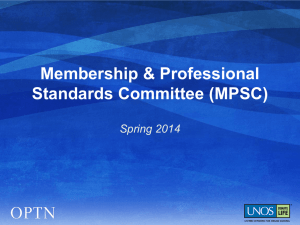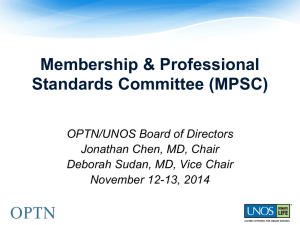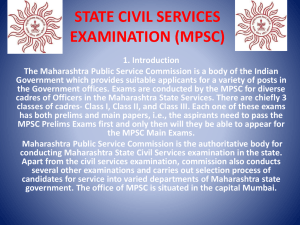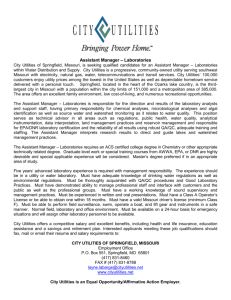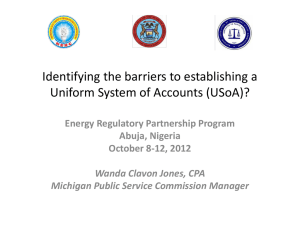Information security II
advertisement
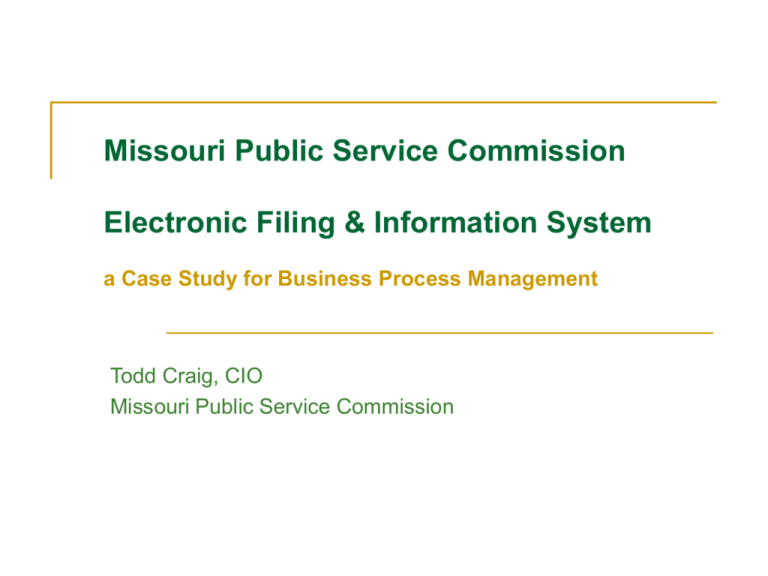
Missouri Public Service Commission Electronic Filing & Information System a Case Study for Business Process Management Todd Craig, CIO Missouri Public Service Commission Overview of MPSC MPSC is a quasi-judicial, regulatory agency that regulates publicly owned utility companies rates and services There are approximately MPSC staff members Over 1000 utilities operating in Missouri Electric, Gas, Telecom, Water, Sewer Some large (AT&T, SBC, AmerenUE), some mediumsized, other are small Serving over 5M residents/potential ratepayers 2 Why Did We Need Change? More Work More Utilities Have Generated 900 800 700 600 1800 1600 1400 1200 500 1000 400 800 300 600 200 400 100 Number of Orders 200 0 1992 1993 1994 Number of Utilities FTE 1995 1996 1997 Headcount vs. Number of Utilities Same or Decreased Staff Size Using Antiquated Computer Systems Number of Tariffs Filed 0 1992 Number of Cases 1993 1994 FTE 1995 1996 1997 Work Overload 3 Compelling Issues No centralized file/data repository Same data stored in many sub-systems, Including legacy mainframe systems, local computers, Access databases, etc. Inefficient and difficult to maintain. Multiple internal systems to handle paper-based documents Tariffs, case filings, withdrawals/ substitution, comments on rulemakings, motions to intervene, applications, complaints, inquiries, outage reports, faxes, etc. Inefficient and difficult to maintain. Manual entry into these systems causing long cycle times. Paper-based case and tariff information Mounds and stacks of paper filings checked in and out from the records room, printed out in multiple copies, stored all over the MPSC - accounting for millions of redundant paper-based documents being stored contributing to long cycle times and inefficiencies. 4 Requirements Systems that had to be integrated: Docket/case management system Tariff system Utility system Consumer services system Data request management Resource library Collaborative case management between legal, technical, services and administration (required business process redesign). 5 Requirements (continued) Must provide secure access to required information for MPSC staff, utility companies, interveners, stakeholders and ratepayers. Must satisfy the State of Missouri eGovernment initiatives – efforts led by the Office of Information Technology (OIT) and the Information Technology Advisory Board (ITAB). Must allow MPSC to operate more effectively and efficiently while reducing the cost of doing business with MPSC. 6 Challenges Over 9M pages of documents on file; with an estimated 1.2M pages added per year Over 1,000 rolls of microfilm; 12,000 microfiche Poor search capabilities; difficulty sharing information internally Docket and consumer legacy systems date back to 1979 Manual entries into multiple legacy systems and filing multiple copies of documents creating long cycle times No integration of documents to dockets, data request to cases Metrics and reports system difficult to manage when they existed at all Ratepayers had poor and inconvenient access to MPSC for complaints, information and education 7 Solution Overview Electronic Filing & Information System (EFIS) One common system for the needs of many initiatives… A web based application for: Electronic filing, tariffs and registration Imaging with OCR Automated workflow Centralized file repository Full text search engine Special publishing needs (appellate filings) Consumer complaint management Performance metrics and reports Resource library 8 System Architecture EFIS is deployed using FileNet’s Business Process Management (BPM) solution with a customized front-end tailored for the MPSC business processes The system uses FileNet’s eProcess to interface between the customized front-end and FileNet’s Content Services for the committal and retrieval of documents FileNet’s eProcess WorkFlo is used for automation of the MPSC’s business processes 9 System Architecture EFIS consists of a central repository for documents (paper scanned and OCR’d or electronically committed) and structured data supporting two related applications, the Case Management System (CMS) and the Customer Quality System (CQS). 10 Before & After • Identified in 1998: • December, 2002: • 158 business processes • 60 business processes • 35 business processes intersecting to the docket system • all 60 business processes intersect with EFIS •64 applications in use •20 independent databases • 9.2M pages of paper stored • 4.6M pages stored redundantly • 1.2M pages expected to be added annually • 10 applications in use • 6 database repositories • 5M pages of paper stored • 1.5M pages stored redundantly • only 50K pages added as of December, 2002 11 Strategic Benefits Improvements to MPSC business processes lower the cycle time that in turn lowers the cost of doing business with MPSC Utility companies save time and money with the ability to do business with MPSC through EFIS Legislators, policy makers and constituents know more about utility rates and issues with easy to access information through EFIS 12 Return On Investment (ROI) Estimated annual savings over $2.6M! Postage and delivery services Printing and document fees Productivity savings* Total estimated savings $140,000 $126,000 $2,407,000 $2,673,000 *Time savings of 2 hours per employee per day realized in many departments. (Estimates provided by the Project Oversight and MPSC Administration) 13 Collateral Savings Recent Example: Southwestern Bell Corporation has stated: In one (1) month they have saved 40 staff hours In one (1) month they have saved 4,440 pages of paper In one (1) month they have saved in postage and courier fees Similar statements have been made by Sprint, AmerenUE, Missouri American Water and many law firms who represent utility companies 14 The Winners Are… MPSC Utilities & Interveners Enjoy secure and efficient interaction with MPSC Receive faster, better quality decisions Save money by reduced cost of doing business with MPSC Ratepayers Effective business processes to help mitigate the increasing work load Ready for the new challenges of regulation Obtain access to information giving them the ability to make educated decisions regarding utility services Easy access to the MPSC Consumer Services and information regarding utility services State of Missouri Provides cost effective services to its residents 15 Questions? Thank You! Visit the Missouri Public Service Commission web at: http://www.psc.mo.gov Or contact: Todd Craig, CIO Missouri Public Service Commission todd.craig@psc.mo.gov 17
